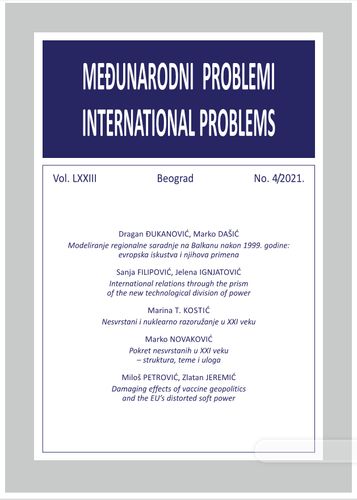Modeliranje regionalne saradnje na Balkanu nakon 1999. godine: evropska iskustva i njihova primena
Modeling regional cooperation in the Balkans after 1999: european experiences and their application
Author(s): Dragan Đukanović, Marko DašićSubject(s): International relations/trade, EU-Accession / EU-DEvelopment, Politics and Identity
Published by: Институт за међународну политику и привреду
Keywords: regional cooperation; cooperation models; Europe; Western Balkans; Benelux; Visegrad Group; Nordic cooperation; Berlin Process;Regional Cooperation Council;
Summary/Abstract: In this paper,the authors comparatively analyze the development ofregional cooperation in Europe after the Second World War and in the Western Balkans since 1999. They compare and contrast regional cooperation in the Western Balkans(with a particular focus on the period after 2006, when the Stability Pact for Southeastern Europe wastransformed into the Regional Cooperation Council, and after 2014, when the Berlin Process was launched) with similar forms of cooperation in Europe, such as the Nordic Council of Ministers, the Visegrad Group, and the Benelux. Therefore, the authors approach a comparative analysis of the composition of these regional forums and their areas of cooperation with the Regional Cooperation Council, the Southeast European Cooperation Process, and the Berlin Process. In thisregard,the authorsstate that there are more than obvious similarities between regional cooperation in the Western Balkans, primarily with the Visegrad Group, and to a significant extent with the Benelux. Regional cooperation on the Balkan Peninsula and between the Nordic countries is similar to a lesser extent, owing to the absence of the formation of the Parliamentary Assembly of the Western Balkans, which was overlooked in 2013. The authors conclude thatthere are numerous obstaclesto establishingmore intensive and deeper regional cooperation in the Western Balkans, the mostsignificant of which are the lack of a multilaterally accepted regional identity, the different interests ofregional leaders regarding its "originality", the conflicted views of dominant opinions, and the predominant influences of various Western actors.
Journal: Међународни проблеми
- Issue Year: LXXIII/2021
- Issue No: 4
- Page Range: 617-636
- Page Count: 20
- Language: Serbian

